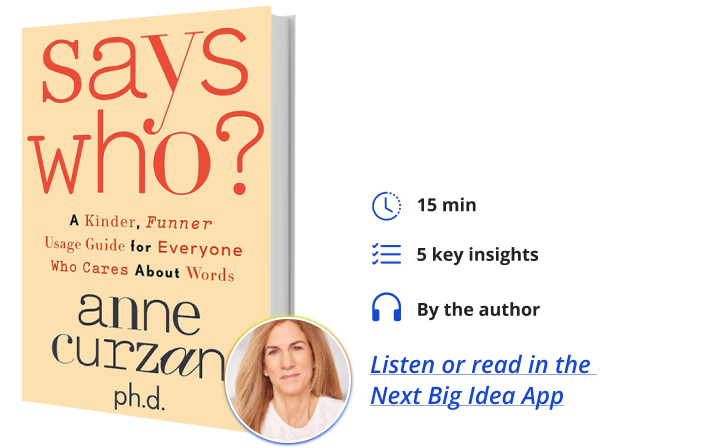Anne Curzan is a professor of English, linguistics, and education at the University of Michigan and is currently Dean of the College of Literature, Science, and the Arts. Her TEDx talk at UM called “What makes a word ‘real’?” has over 1.2 million views on the national TED site.
Below, Anne shares five key insights from her new book, Says Who?: A Kinder, Funner Usage Guide for Everyone Who Cares About Words. Listen to the audio version—read by Anne herself—in the Next Big Idea App.

1. The English language is always changing, which can seem much cooler in retrospect than it does in the moment.
One of the great things about spending time with undergraduates is that I get to learn about all the changes happening in English. The phrase “on accident” is replacing “by accident.” The period in texting is serious and often angry. Lol no longer means “laughing out loud;” the new verb to verse has popped up meaning “to play against;” and the word hoi polloi is dying. Like is a quotative (“And I was like, ‘You have got to be kidding!’”), and they is a nonbinary singular pronoun.
Maybe you are gritting your teeth. Maybe these examples feel like proof that English is on the road to ruin. I promise, it’s not. It’s just changing, as it has always done.
And when we hear examples of past changes, they usually don’t seem that worrisome. The word nice used to mean “silly,” lollygag meant “mess around” (in the kissing sense), and decimate involved killing one in every ten. These facts are just interesting.
English, like every living language, changes because every child is reinventing the language as they learn it; because we as humans are creative speakers who make up new words to meet the moment and use words in novel combinations; because English speakers come into contact with other languages and often speak other languages alongside English; and because one change in the language can spur other changes. This ever-changingness keeps me in business as a linguist who studies the history of the English language. It also should remind all of us that the English language is going to be fine—and that it could be good for our blood pressure to be more curious than cranky about the language changes we see and hear all around us.
2. “Right” and “wrong” in language are not as clear-cut as we learned in school.
I grew up with a very prescriptive mother who had strong ideas about what was “right” and “wrong” in language. These ideas were reinforced in school by many an English teacher. Don’t split an infinitive. Don’t end a sentence with a preposition. The grocery store sign “10 items or less” is wrong.
This book encourages you to ask “Says who?” when you are confronted with these rules, so that you can learn more about where they originate and how well-founded they are. In English, we can split an infinitive and often it sounds better to boldly go into this split infinitive territory. The first grammarian who advanced the idea that it was elegant not to end a sentence with a preposition, back in the 18th century, explicitly admitted that we end sentences with prepositions all the time—and he even made a joke about it. Then somewhere along the way we lost our sense of humor about those sentence-final prepositions.
“Prescriptive rules can act as gatekeepers and exclude in ways that are not on solid linguistic ground.”
Some prescriptive rules are helpful. They can help us avoid ambiguity in writing, which is important because as a writer, we’re usually not there to clarify if there is confusion about what we mean. Sometimes this more prescriptive guidance can help us create aesthetically pleasing and effective prose for the context, including using more inclusive language. But some of these prescriptive rules are not well-justified: for example, there is nothing fundamentally wrong with using hopefully to mean “it is hoped.” And clinging to the idea that, say, whom remains the only “correct” object form of who, in every context, can make our language seem stilted and not right for the demands of the moment.
It’s also true that prescriptive rules and notions of “proper usage” change over time. Grammarians used to condemn the then-new verbs donate and finalize. And they hated the passive progressive (as in, “The house is being built”) when it first showed up in the 19th century. Now we can’t imagine English without it.
Prescriptive rules can act as gatekeepers and exclude in ways that are not on solid linguistic ground. So, we should use caution with the words “right” and “wrong” given the realities of how language works, how it changes over time, and how attitudes about what is right and wrong also change over time.
3. We should get to know both our inner grammando and inner wordie.
We all have an inner wordie who really enjoys language. Maybe we play Wordle or Spelling Bee every morning, or enjoy a game of Scrabble or Boggle. We pun, write poetry and song lyrics, and make up playful new slang. We’re often curious about oddities in English like why colonel is spelled like that.
We also each have an inner grammando. The word grammando was introduced by Lizzie Skurnick in the New York Times Magazine in 2012 for those who correct other people’s grammar, such as trying to get people to stop saying irregardless. Or funner. Our inner grammando’s first impulse may be to resist language change, to cling to ideas about correctness, and to judge new or unfamiliar bits of language as wrong. Even though I’m a linguist who loves studying language change, I still have an inner grammando who hears things like the relatively new word impactful and thinks, “Does the language really have to change that way?”
The key for each of us is to engage with both our inner wordie and our inner grammando so that we can become ever more savvy and informed speakers, writers, readers, and listeners, and perhaps teachers and editors. We should push our inner grammando to see how justified our reactions are and figure out what language will be rhetorically effective, given the audience and context. This is where our inner wordie can help. We can think of our inner wordie as the skilled birdwatcher of language, always curious to learn more and expand our rhetorical toolbox.
So, what do I do about impactful? I wince inside and then I keep my mouth shut, and my pen quiet. The fact that Anne Curzan, in 2024, still doesn’t like the word impactful is irrelevant to the history of English. The word is increasingly popular, and it is well-formed linguistically. There is nothing wrong with it other than being relatively new. And I’ll get over it.
4. Linguistic diversity is part of cultural diversity.
Language is a key part of our identity. The way we speak (or sign) and write reflects the communities we grew up in and the communities we identify with. Language is deeply personal, which is why criticizing other people’s language can be such a powerful move.
When you think about it, every definition of culture includes language. So, part of being a multicultural society is embracing the diverse ways we speak–including, in the United States and other English-speaking countries, many dialects of English and many languages.
“Every variety of a language is equally rule-governed and logical.”
There are standardized varieties of English, which can be very useful. But a standardized variety is not linguistically “better” than all the other varieties—it’s just the standardized variety. Every variety of a language is equally rule-governed and logical. What does that mean? It means that, for example, double negation (“We don’t have none”) used to occur in all varieties of English, as it does in languages around the world. There was double, and even multiple, negation in the time of Beowulf and Chaucer. The variety that became standardized English moved to single negation (“We don’t have any”), while many other varieties of English maintained double negation. Different varieties, different rules.
The link between language and identity, language and culture, language and community, helps explain why debates about language are almost always about more than language. They’re about people, power, politics, and more.
5. We can care deeply about language and be kind to each other.
Sometimes I’ll hear people equate caring about language with meticulously correcting the language of others, according to a strict set of prescriptive rules. It doesn’t have to be that way.
Caring about language can involve curiosity about how language changes and varies across time and communities. Caring about language can be asking lots of questions about which rules we learned in school are most helpful to being effective, savvy writers across genres and audiences—and we can then give ourselves and others permission not to adhere to notions of correctness that are not helpful. Caring about language can be striving to use language to include rather than exclude.
I encourage us all to remember the birdwatcher analogy: When we hear or see something new in the language (a new usage bird), we should let ourselves feel that spark of inquisitiveness and seek to understand what we’re seeing and hearing, rather than trying to kill the new language bird!
When we approach language this way, we can be more generous with each other as speakers and writers. We can embrace both change and variation in language—which lets us expand our own and others’ rhetorical toolboxes to use lots of kinds of language effectively, in even more settings. Let’s think more capaciously about effectiveness, rather than correctness. And then those of us who have the power to be language gatekeepers can use our roles to open the gates wider to allow a more diverse set of speakers and writers to feel welcomed.
To listen to the audio version read by author Anne Curzan, download the Next Big Idea App today:































